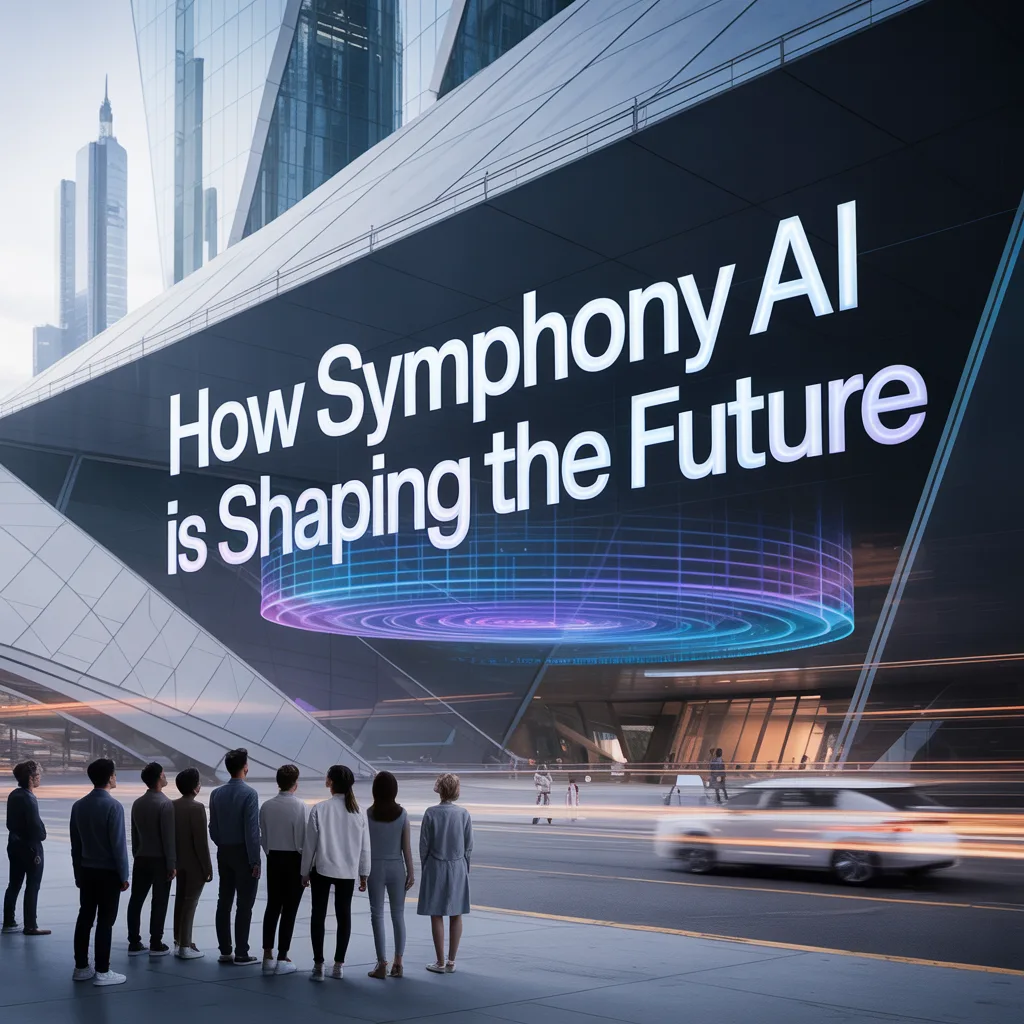How Symphony AI Is Shaping the Future of Enterprise Artificial Intelligence
October 06, 2025 | Gudstory Org AI News
Thank you for reading this post, don't forget to subscribe!In an era where artificial intelligence has moved from experimental technology to essential business infrastructure, one company is distinguishing itself by delivering AI solutions that don’t just promise transformation but actually deliver measurable results. Symphony AI, the enterprise AI powerhouse founded in 2017, is redefining how organizations across multiple industries harness the power of artificial intelligence to solve their most pressing operational challenges.
From Startup to Industry Leader
What began as an ambitious venture has evolved into a formidable force in enterprise AI, with the company now employing over 3,000 professionals spread across the globe. This rapid expansion reflects not just growth for its own sake, but rather the increasing demand for AI solutions that actually work in real-world business environments. Unlike many AI companies that focus on building generic platforms or offering consulting services, SymphonyAI has carved out a distinctive niche by developing packaged AI Software-as-a-Service applications tailored to specific industry verticals.
The Three Pillars of Modern AI
At the heart of SymphonyAI’s approach lies a sophisticated integration of three distinct AI methodologies: predictive AI, generative AI, and the emerging field of agentic AI. This tri-faceted strategy represents a significant departure from companies that focus exclusively on one type of artificial intelligence.
Predictive AI enables organizations to anticipate future outcomes based on historical data patterns, allowing businesses to make proactive decisions rather than reactive ones. Generative AI, which has captured public imagination through applications like large language models, creates new content and solutions based on learned patterns. Most intriguingly, agentic AI represents the cutting edge of autonomous systems that can make decisions and take actions with minimal human intervention.
By combining these three approaches, SymphonyAI delivers solutions that can analyze past trends, generate intelligent recommendations, and autonomously execute decisions—a comprehensive AI capability that few competitors can match.
Industry-Specific Intelligence: The Vertical Advantage
Perhaps the most significant differentiator in SymphonyAI’s strategy is its commitment to vertical-specific solutions. Rather than offering a one-size-fits-all platform that businesses must adapt to their needs, the company has developed specialized divisions addressing distinct industries with unique challenges.
Financial Services and Crime Prevention: In the financial sector, where fraud detection and regulatory compliance are paramount, SymphonyAI’s solutions help institutions identify suspicious patterns and protect against financial crimes before they occur.
Retail and Consumer Packaged Goods: For retailers and CPG companies, the platform delivers personalized recommendations and optimizes operations, helping businesses understand consumer behavior at a granular level and respond to market dynamics in real time.
Industrial Manufacturing: In the manufacturing sector, SymphonyAI is bringing AI directly to the factory floor through edge computing solutions. This approach processes data where it’s generated, enabling real-time decision-making for predictive maintenance and process optimization.
Media and Entertainment: The company’s Revedia platform is transforming how media companies manage content, unify data, and derive actionable insights from their vast libraries of audio and video assets.
Enterprise IT: Through its backend platform designed for IT service management, SymphonyAI is revolutionizing how organizations handle everything from employee onboarding to ongoing technical support.
The Eureka AI Platform: Foundation for Innovation
Underpinning all of SymphonyAI’s industry-specific applications is the Eureka AI platform, a sophisticated infrastructure that provides the technical foundation for deploying AI at enterprise scale. This platform approach offers several critical advantages: it enables faster deployment times, ensures consistency across different applications, and provides the security and compliance features that large enterprises require.
The platform’s flexibility is particularly noteworthy, supporting deployment models ranging from cloud-based implementations to edge computing scenarios where AI processing happens close to data sources. This versatility proves essential in industries like manufacturing, where real-time processing can mean the difference between preventing equipment failure and experiencing costly downtime.
Agentic AI at the Edge: The Next Frontier
One of SymphonyAI’s most innovative initiatives involves deploying agentic AI at the edge—embedding intelligent decision-making capabilities directly into machines and processes on factory floors. This represents a fundamental shift from AI that merely analyzes operations to AI that actively manages them.
Through collaboration with Microsoft’s Azure IoT Operations, SymphonyAI is bringing advanced analytics closer to where data originates. This proximity eliminates the latency associated with sending data to centralized systems, enabling split-second decisions that optimize operations, predict equipment failures before they occur, and enhance overall manufacturing efficiency.
The implications extend beyond mere speed improvements. By processing data at the edge, manufacturers can maintain operational continuity even when internet connectivity is intermittent, a common challenge in industrial environments. Additionally, this approach addresses data privacy and sovereignty concerns by keeping sensitive operational data within the organization’s own infrastructure.
Strategic Partnerships Amplifying Impact
SymphonyAI’s relationship with Microsoft exemplifies how strategic technology partnerships can multiply the impact of AI solutions. By leveraging Azure Kubernetes Service, Azure OpenAI Service, and other Microsoft cloud technologies, SymphonyAI delivers enterprise-grade scalability, availability, and management capabilities that would be extraordinarily difficult and expensive to build independently.
These partnerships aren’t merely vendor relationships but represent deep technical integrations that enhance the capabilities of both platforms. The collaboration enables SymphonyAI to focus on what it does best—developing industry-specific AI applications—while relying on proven cloud infrastructure for the heavy lifting of scaling and securing those applications.
Recognition and Industry Validation
The company’s approach is garnering recognition from independent analysts. Recent positioning as a leader in industrial AI analytics software by research firm Verdantix validates SymphonyAI’s dual excellence in both industrial data management and applied AI—a rare combination that demonstrates comprehensive capability across the AI value chain.
This recognition is particularly significant because it comes from an independent third party evaluating the actual capabilities and real-world results of AI solutions, not just marketing promises or theoretical potential.
Accelerating Time-to-Value
In the enterprise software world, the gap between purchase and productive use—known as time-to-value—often stretches painfully long. Organizations can spend months or years implementing systems before seeing meaningful returns. SymphonyAI addresses this challenge head-on with packaged applications that are ready to deploy, rather than requiring extensive customization for each client.
This “productized” approach to AI doesn’t mean sacrificing flexibility. Instead, it reflects deep industry expertise that has anticipated common challenges and built solutions that address them out of the box, while still allowing for necessary customization where businesses have truly unique requirements.
Democratizing AI Across Organizational Roles
Another noteworthy aspect of SymphonyAI’s approach involves making AI accessible to diverse roles within organizations, not just data scientists or technical specialists. By building interfaces and workflows tailored to how different professionals actually work, the company is democratizing access to AI-powered insights.
A plant manager can leverage predictive maintenance capabilities without needing to understand the underlying machine learning algorithms. A retail merchant can access consumer insights without becoming a data scientist. This accessibility dramatically expands the potential impact of AI within organizations by putting powerful tools in the hands of people who understand the business context and can act on AI-generated insights.
Security and Compliance: Table Stakes for Enterprise AI
Enterprise adoption of AI hinges not just on capability but on trust. SymphonyAI recognizes that robust security measures and compliance frameworks aren’t optional extras but fundamental requirements. By building these considerations into its platform from the ground up rather than bolting them on afterward, the company ensures that organizations can confidently deploy AI solutions without compromising their security posture or regulatory compliance.
This attention to security proves particularly crucial in regulated industries like financial services, where the consequences of data breaches or compliance failures can be severe. By partnering with established cloud providers like Microsoft Azure and adhering to stringent security standards, SymphonyAI provides the assurance that enterprise customers require.
The Road Ahead: From Automation to Augmentation
Looking forward, SymphonyAI’s trajectory suggests a future where AI moves beyond simply automating existing processes to fundamentally augmenting human capabilities. The evolution from predictive analytics to agentic systems that can autonomously make and execute decisions represents just the beginning of this transformation.
The convergence of AI types—predictive, generative, and agentic—working in concert promises to unlock capabilities that individual approaches cannot achieve alone. Imagine manufacturing systems that not only predict when equipment will fail but generate optimal maintenance schedules and autonomously coordinate the necessary repairs. Or retail systems that predict consumer demand, generate personalized marketing content, and autonomously adjust inventory and pricing.
Challenges and Considerations
Despite the impressive progress, implementing enterprise AI at scale presents ongoing challenges. Data quality remains a persistent issue—AI systems are only as good as the data they learn from. Integration with legacy systems that weren’t designed with AI in mind creates technical complexity. And the pace of AI advancement means that today’s cutting-edge solutions may be outdated within years.
SymphonyAI’s platform approach helps address some of these challenges by providing a consistent foundation that can evolve as AI technologies advance. However, the company and its customers must remain vigilant about maintaining data hygiene, ensuring ethical AI use, and managing the organizational change that comes with AI adoption.
Conclusion: Practical AI for Real Business Problems
In an AI landscape often characterized by hype exceeding substance, SymphonyAI stands out by focusing relentlessly on solving actual business problems with measurable results. The company’s vertical-specific approach, combining multiple AI methodologies, and emphasis on ready-to-deploy solutions addresses the fundamental challenge that has held back enterprise AI adoption: the gap between theoretical potential and practical implementation.
As organizations across industries grapple with increasing complexity, competitive pressure, and the need to do more with less, AI is transitioning from competitive advantage to competitive necessity. Companies like SymphonyAI that can deliver AI solutions that actually work—deployed quickly, integrated smoothly, and delivering clear ROI—will play an increasingly central role in shaping how businesses operate in the coming decade.
The future of enterprise AI won’t be determined by which companies can build the most sophisticated algorithms or generate the most impressive demos. Instead, it will be shaped by organizations that can translate AI’s immense potential into practical applications that help businesses operate more efficiently, make better decisions, and create more value for their customers. By that measure, SymphonyAI is indeed shaping the future of enterprise artificial intelligence—one deployed solution at a time.


